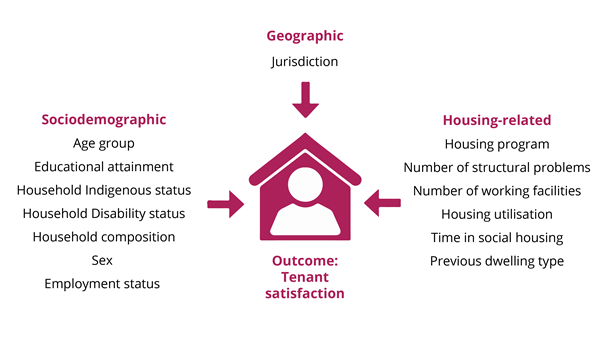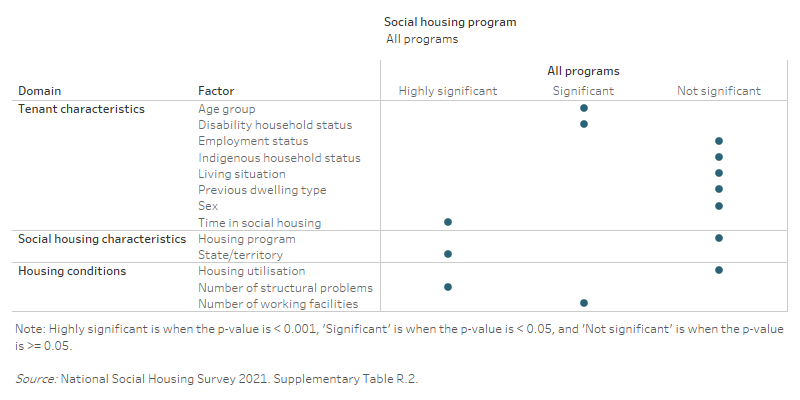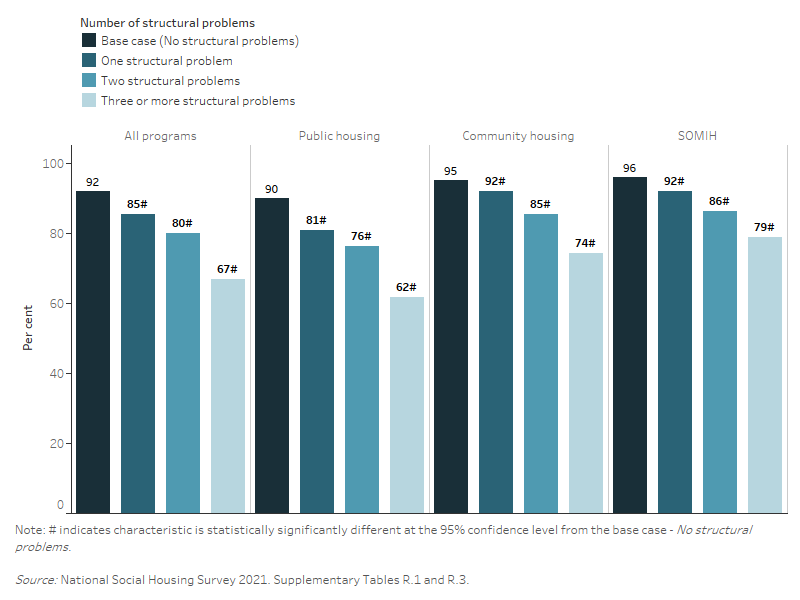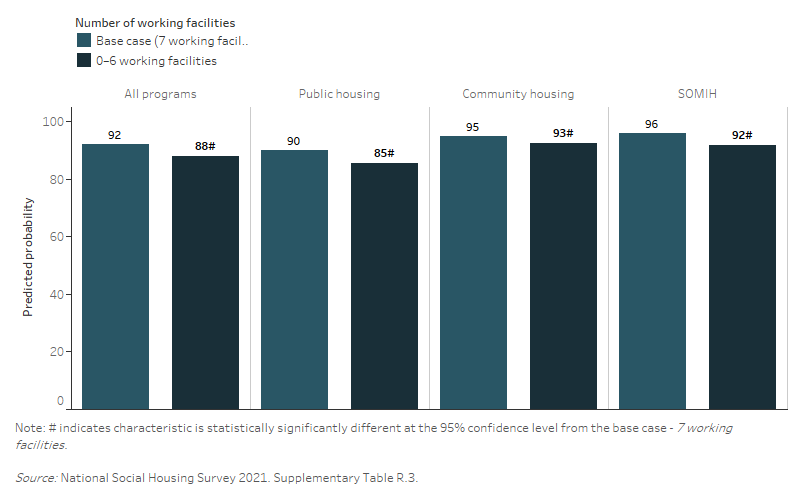What were the key factors in tenant satisfaction?
On this page:
- Understanding regression and differences in tenant satisfaction
- Which factors were significantly associated with tenant satisfaction?
- Which housing conditions affect tenant satisfaction?
- Which household characteristics affect tenant satisfaction?
- Which social housing factors affect tenant satisfaction?
- References
In 2021, three-quarters of social housing tenants (73%) were satisfied with the overall services provided by their housing organisation (see Figure Satisfaction.1, Table S1.1). However, the underlying reasons why tenants were satisfied – or dissatisfied – are relative to their lived experience of social housing (Pawson and Sosenko 2011). The pathways from living in social housing to being satisfied with living in social housing are as diverse as individual experiences of social housing (Garnham et al. 2021).
To better understand the Australian social housing experience, a range of aspects of the social housing experience were examined. The goal of the following analyses was to identify which factors were related to tenant satisfaction, both within and between social housing programs.
Understanding regression and differences in tenant satisfaction
Regression analysis is a statistical technique used to understand relationships among multiple variables. It examines the strength of the relationship between the specified factors and an outcome (such as tenant satisfaction), while holding other factors equal. Here, a logistic regression analysis was used to determine the relationships between multiple ‘factors’ (such as tenant age, location, or condition of the dwelling) and tenant satisfaction.
The regression model included key geographic, sociodemographic and housing-related factors. Although other factors (such as tenants' housing expectations) likely contribute to tenant satisfaction, only the directly measurable aspects of social housing were included as factors to maintain direct relevance to social housing performance.
Identifying key factors in tenant satisfaction using logistic regression analysis
Logistic regression analysis is a way to examine relationships between multiple factors (for example, social housing program, location and condition) with an outcome (such as tenant satisfaction). This statistical technique shows which individual factors are significantly associated with tenant satisfaction, after accounting for other factors included in the model (see, for example, Sperandei 2014); or in other words, when all else is equal between tenants. Using NSHS data, a regression model for tenant satisfaction (illustrated below) was developed to include housing-related, geographic and sociodemographic factors.

The regression model is used to explore how likely it is that a tenant with a particular set of characteristics would be satisfied with their housing services. The value of the technique is that it allows comparisons of the ‘predicted probabilities’ for 2 tenant groups that differ by a single characteristic, when all else is equal (or held constant). If the model identifies a statistically significant difference, this suggests there could be a relationship between the factor in question and tenant satisfaction – a relationship that holds after accounting for all factors included in the model.
To create a point of reference, a base case is assigned for each variable in the model so that the direction and size of a factor’s relationship with satisfaction can be seen. See Table C1 for the categories and base cases for all factors in the model. The reference group is a hypothetical group of tenants with all the base case characteristics combined. This provides a point of reference only and does not affect the findings. All estimates (such as predicted probabilities) presented in this report are in reference to the base case. See the technical notes for a detailed description of the base case.
The base cases for each variable were chosen because they provide a useful point of reference. For example, they were the bottom or top of a variable range (for example, age group); they represented the most common group (for example, public housing); or they appear to have higher satisfaction levels (for example, Queensland).
This report presents the predicted probability of satisfaction for tenants in the reference group and shows how predicted satisfaction changes for tenants who differ on just one characteristic. For example, in the section on dwelling condition, the likelihood of being satisfied for tenants with structural problems is compared with those with no structural problems (the base case), while accounting for other factors. Predicted probabilities are presented as percentages but differ from the descriptive proportions included elsewhere in this report.
The technical notes present detailed information about the regression method and results.
Tips on interpreting regression results
Statistically significant results are when differences in results between groups or associations between a factor and result met a required statistical benchmark of confidence. Throughout this report, the term ‘significantly’ refers to statistically significant. More information on understanding significance is outlined in the introduction.
Which factors were significantly associated with tenant satisfaction?
There are a range of factors that were significantly associated with tenant satisfaction for all social housing tenants and among tenants of the three social housing programs surveyed in 2021 (Figure Factors.1, Table R.2). Some factors were not statistically for significant for social housing tenants collectively but were statistically significant for tenants within specific social housing programs.
Figure Factors.1. Summary of factors associated with tenant satisfaction, by social housing program, 2021
This interactive table shows which factors were significantly associated with tenant satisfaction for each of the housing programs.

Only those results for factors that were significant among all social housing tenants are presented in this section. Also, only when a factor was found to be significant among all social housing tenants, are the results for tenants within each of the specific programs presented. The results for the non-significant factors and those unique to specific programs can be found in the supplementary tables.
Which housing conditions affect tenant satisfaction?
Housing conditions relate to the physical characteristics and quality of the dwelling, such as its structure, facilities and amenities. Whether a home is structurally sound and has access to working facilities is a key aspect of any housing experience, as it has the potential to influence multiple aspects of health and wellbeing, such as respiratory health and mental health (Baker et al. 2016; Clapham et al. 2017; Fujiwara 2013).
Likewise, whether a home is appropriate for a person’s household size is another key aspect of the housing experience, as it can also influence multiple aspects of tenants’ wellbeing, such as their sense of space and privacy (Dockery et al. 2022).
Structural problems affect tenant satisfaction
NSHS question about structural problems
NSHS respondents were asked if their home had any of the following problems:
- Major electrical problems
- Major plumbing problems
- Major cracks in walls/floors
- Walls/windows not square (out of alignment)
- Wood rot/termite damage
- Sinking/moving foundations
- Sagging floors
- Major roof problems
- Rising damp
- Other structural problems
'The ceiling in the bathroom has been leaking for a long time, repair people keep saying there is no money to fix it properly.'
'Extremely worn floorboards with protruding nails in main living area, front door not sealed at bottom allowing cold air to blow in, large wall splits in outside walls, paint peeling in bathroom and mould issues throughout the home.'
Structural problems were a highly significant factor in tenant satisfaction. The more structural problems a tenant had with their social housing dwelling, the less likely the tenant will be satisfied (Figure Factors.2, Table R.2). Within each housing program, tenants living in a dwelling with one or more structural problems were less likely to be satisfied than those without, when all other factors were considered equal.
Figure Factors.2 Predicted probability (%) of being satisfied with the overall service provided by their housing organisation, by the number of structural problems and social housing program, 2021
This interactive bar chart shows the tenant satisfaction (predicted probability) decreased with increasing number of structural problems. This trend was consistent across housing programs and states and territories.

'Ongoing issue with excess moisture in the roof and running down interior walls.'
'The bathroom floor (vinyl flooring) is now bubbly and springy from being damp, the floor surface is not level. This is a health and safety hazard and could cause me to trip, slip and fall.'
Access to working facilities affects tenant satisfaction
Access to working facilities – such as cooking facilities, a refrigerator, bath or shower, toilet, a washing machine, kitchen sink and laundry tub – is a key aspect of housing condition that may affect tenant satisfaction. Tenants were asked whether they had access to 7 different working facilities in their social housing dwelling. Note that the following findings do not differentiate between facilities that are the ownership or responsibility of the housing provider or tenant.
Tenants with access to all 7 working facilities were more likely to be satisfied than those without (Figure Factors.3, Table R.3). When all else was considered equal, tenants with access to 6 or less working facilities were significantly less likely to be satisfied than tenants that had access to all 7 facilities. This was true in all models tested. Despite the significant difference, the predicted probability for tenants with access to 6 or fewer facilities was 3–4 percentage points lower than the base case.
Refer to the introduction for more information on interpreting statistically significant results.
'Why was a community housing building allowed to be built without integral air conditioning in this hot climate?'
Figure Factors.3: Predicted probability (%) of being satisfied with the overall service provided by an organisation, by the number of working facilities and social housing program, 2021
This interactive bar chart shows that tenant satisfaction (predicted probability) was significantly lower when there were less than seven working facilities. This trend was consistent across housing programs.

'Regarding the shared laundry room, we have two washing machines and two dryers. One of each have been broken for over 4 months which is ridiculous to share a single washing machine and dryer between over ten apartments.'
Which household characteristics affect tenant satisfaction?
Households seeking social housing often have members with special needs. Some households may have one or more members with multiple special needs.
Living with disability in the household affects tenant satisfaction
Tenants in households with a person with disability were less likely to be satisfied than tenants in other households, when all else was equal (Table R.2). However, among each of the specific programs significant differences were only evident for tenants in public housing and SOMIH (Table R.3).
Age affects tenant satisfaction
Age was significantly associated with the likelihood of tenant satisfaction (Table R.2). Compared to tenants aged 0–34, tenants aged 45–54 and, especially, those aged 65 or over were significantly more likely to be satisfied, when all else was equal. However, there was not statistically significant difference between tenants aged 0–34 and those aged 35–44 or 55–64.
Age affects tenant satisfaction differently among some of the social housing programs, however, the models indicate very high satisfaction for each age group (ranging from 90% to 95%), when all else is considered.
Tenancy length affects tenant satisfaction
Tenancy length was significantly associated with tenant satisfaction (Table R.2). With all else being equal, tenants who had lived in social housing for over 16 years or for 6–10 years were less likely to be satisfied than tenants who had lived in social housing for 0–5 years. However, tenants who had lived in social housing for 11–15 years were not significantly different from those who lived in social housing for 0–5 years.
Which social housing factors affect tenant satisfaction?
State location affects tenant satisfaction, but housing program does not
Housing program was not significantly associated with tenant satisfaction (Table R.2). With all else being equal, tenant satisfaction between public housing and community housing or public housing and SOMIH tenants were not significantly associated. This indicates that the higher satisfaction rates apparent in community housing tenants may mostly be explained by factors, such as the absence of structural problems (Figure Factors.2, Table R.3), rather than the specific housing program.
In contrast, the state or territory a tenant lived in was associated with how likely they were to be satisfied. State or territory was significantly associated with tenant satisfaction among social housing tenants, as well as among comparable tenants within public housing and SOMIH. With all else being equal, social housing tenants in Queensland were significantly more likely to be satisfied than those in New South Wales, Victoria and the Australian Capital Territory.
When tenants were compared only with others within their program, the pattern was similar among public housing tenants and SOMIH tenants.
See Technical notes for detailed information on these results. Other findings from the regression analysis relate to priority populations. These are described in the following section.
Baker E, Lester H, Bentley R, and Beer A (2016) ‘Poor housing quality: Prevalence and health effects’, Journal of Prevention & Intervention in the Community, 44:4, 219-232.
Clapham D, Foye C and Christian J (2017) ‘The concept of subjective well-being in housing research’, Housing, Theory and Society, 35(3):261-280.
Dockery A, Moskos M, Isherwood L and Harris M (2022) ‘How many in a crowd? Assessing overcrowding measures in Australian housing, AHURI Final Report No.382, Australian Housing and Urban Research Institute (AHURI), Melbourne.
Fujiwara D (2013) ‘The Social Impact of Housing Providers’, HACT, London.
Garnham L, Rolfe S, Anderson I, Seaman P, Godwin J and Donaldson C (2021) ‘Intervening in the cycle of poverty, poor housing and poor health: the role of housing providers in enhancing tenants’ mental wellbeing’, Journal of Housing and the Built Environment, 37(1):1–21.
Pawson H and Sosenko F (2011) “Tenant satisfaction assessment in social housing in England: How reliable? How meaningful?’, International Journal of Consumer Studies, 36(1): 70-79.
Sperandei S (2014) ‘Understanding logistic regression analysis’ Biochemia Medica 24(1): 12–18 .


